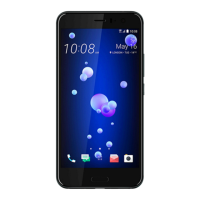Device Settings 215
Note: If you're using your SD card as internal storage, your computer will only show SD card content.
1. Connect your phone to the computer using the supplied USB cable.
2. On your phone, unlock the screen if it's locked.
3. On the pop-up message that asks whether to use USB for file transfers, tap Yes. If you don't see
this message, slide the notification panel open, tap the Use USB for notification, and then tap
Transfer files.
You'll then see options for viewing or importing files on the computer screen.
4. Choose to view files.
5. Copy the files from your computer to your phone, or vice versa.
6. After copying the files, disconnect the phone from the computer.
Make More Storage Space
As you use your phone, you’ll accumulate data and fill its storage capacity over time. Here are some tips
on how to increase storage space.
Manage Photos and Videos
● After taking continuous camera shots, keep only the best shot and discard the rest, if you don't
need them.
● After editing a photo or trimming a video, the original file is kept. Delete original files or move
them to online storage or to your computer.
● If you are only sending videos through MMS, use a lower resolution. High-resolution video takes
up more space.
● RAW image files take up a lot of storage space. It's recommended to use an SD card as the
default storage for photos and videos. If your SD card is running low on space, consider moving
RAW image files to your computer.
Remove Unused Themes
Themes can quickly consume storage space because themes can include images, sounds and icons.
Remove themes you're not using. For details, see Delete a Theme.
Back up Data and Files
Keep only the most recent data in your apps and files that you often need to use. You can back up your
other data and files. For some tips, see Backup.
Remove or Disable Apps
Uninstall apps that you've downloaded if no longer need them. See Uninstall Third-party Apps.
Preinstalled apps can be disabled when you're not using them. See Disable Apps.

